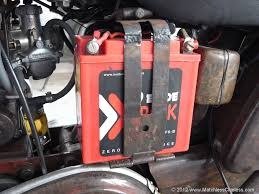Motorbike Battery vs. Car Battery: Key Design Differences
When it comes to powering your vehicle, not all batteries are built the same. One of the most common questions asked by first-time riders and DIY mechanics is: what exactly sets a motorbike battery apart from a standard car battery? While both serve the fundamental purpose of starting the engine and powering electrical components, their design, size, output, and use cases differ significantly.
Let’s start with the most obvious difference—size. A motorbike battery is typically much smaller and lighter than a car battery. This reduction in size isn’t just for convenience; it’s an intentional design that takes into account the space constraints and weight considerations of motorcycles, scooters, and other power sport vehicles. Unlike car batteries, which can weigh 40 pounds or more, motorbike batteries generally weigh under 15 pounds.
In terms of voltage, most motorcycles use a 12-volt system similar to that of a car. However, the cranking amps (CA) and cold cranking amps (CCA)—which refer to the battery’s ability to start an engine in cold temperatures—are much lower in motorbike batteries. That’s because motorcycles require less power to start and run, making high CCA ratings unnecessary. In contrast, a car’s larger engine demands a battery that can provide a higher burst of power to get everything moving, especially in cold weather.
Another distinction lies in the battery chemistry and internal construction. Motorbike batteries are often designed with absorbent glass mat (AGM) technology or even lithium-ion configurations for high-performance bikes. These types allow for sealed, maintenance-free operation, better vibration resistance, and longer life cycles. Standard car batteries are usually lead-acid, although AGM options exist for higher-end models. The specific chemistry plays a role in weight, performance, and longevity.
How to Choose the Right Battery for Your Vehicle
Choosing the correct battery starts with understanding your vehicle’s specifications. Every car or motorcycle comes with manufacturer-recommended guidelines for battery size, type, and terminal configuration. If you’re unsure, using a vin number lookup can provide a quick way to identify the exact make, model, and required parts for your vehicle—including battery options that are compatible.
Motorbike batteries come in several sizes and performance levels. Riders who use their bike for short trips or seasonal use may only need a conventional lead-acid battery. However, for daily commuters or riders in extreme weather conditions, an AGM or lithium-ion battery is often worth the upgrade due to their longevity and resistance to heat, cold, and vibration. On the other hand, car owners should consider factors such as driving habits, vehicle age, and regional climate when selecting a battery. If your car is equipped with start-stop technology or a lot of electronics, a high-performance AGM battery may be more appropriate.
You should also consider the battery’s reserve capacity—how long it can run essential systems if the alternator fails—as well as warranty terms and ease of installation. For motorcycle owners, ease of maintenance is another important factor, especially if the battery will be stored for long periods. A battery tender or trickle charger is often recommended to maintain charge during off-seasons.
Finally, consider the brand and warranty. Reputable brands often provide better support, longer-lasting components, and nationwide warranty coverage. Don’t just shop by price—choosing the cheapest option can leave you stranded or result in frequent replacements.
If you’re driving a hybrid or electric vehicle, such as a Toyota Prius, battery selection becomes even more specialized. A prius battery involves a different system entirely, including a hybrid drive battery pack and a smaller 12-volt battery to power onboard electronics. Replacing or servicing these systems requires expert guidance and the correct OEM-compatible parts.
What Is The Difference Between a Motorbike Battery And Standard Car Battery

Leave a comment
Leave a comment








